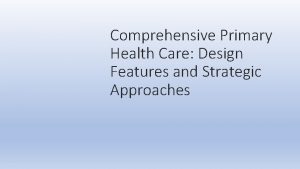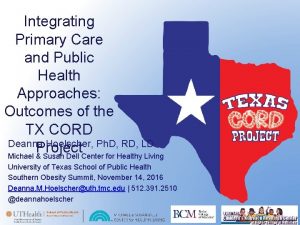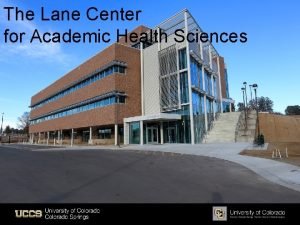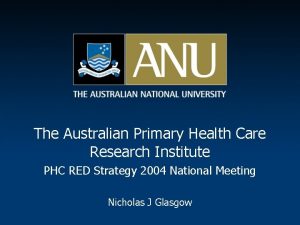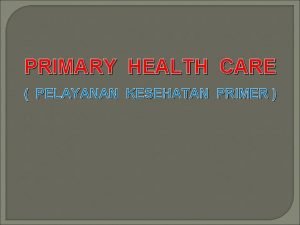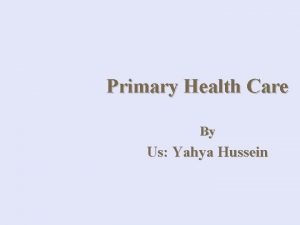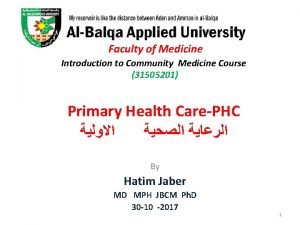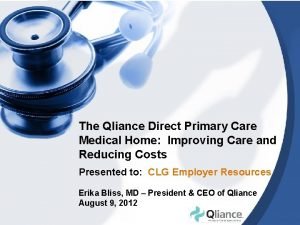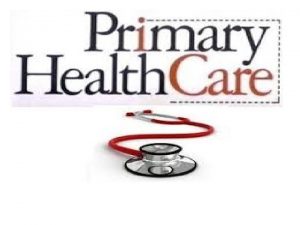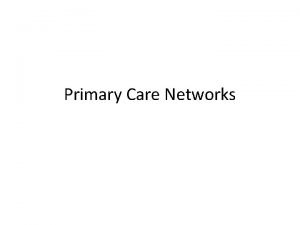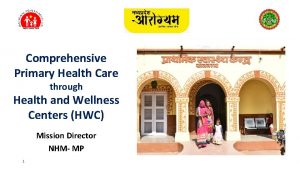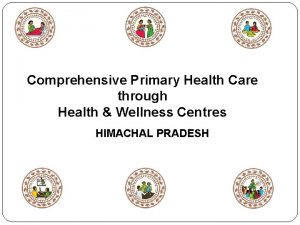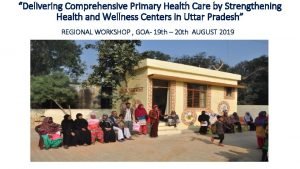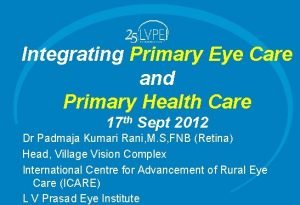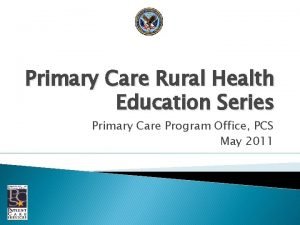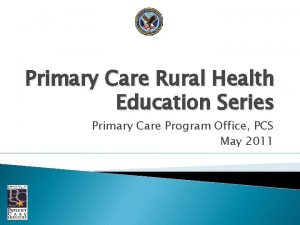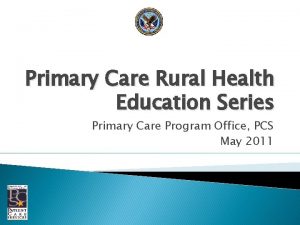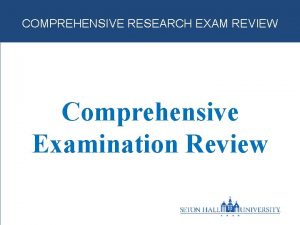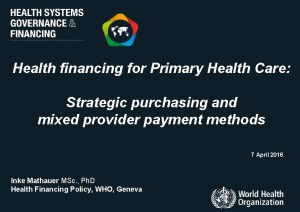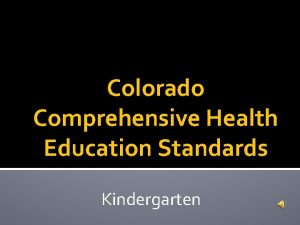Comprehensive Primary Health Care Design Features and Strategic

















- Slides: 17

Comprehensive Primary Health Care: Design Features and Strategic Approaches

Challenges to CPHC and Design Principles 1. Selective primary health care: limited to RCH/few infectious diseases; not in consonance with changes in demography and disease burden 2. Growing burden of NCDs – 62% of mortality due to NCDs ; 55% is premature. requires prevention, early detection, and long- term follow up. 3. Low use of Primary Health Care facilities: 11% of people in rural areas and 3% in urban areas, reported seeking care below CHC. 4. Only 8 % of Out Patient care is provided by primary care facilities in public sector. 5. Fragmented care: increases burden on secondary and tertiary facilities: compromises quality. 6. Exclusion and marginalization 1. Provision of 12 essential PHC packages 2. Prioritize universal screening and management of common non communicable diseases- Leverage NPCDCS 3. Transform Sub centres/PHC to Health and Wellness centres by increasing human and financial resources to increase footfalls- close to community 4. Increase in service package, backed by availability of drugs for chronic diseases and point of care diagnostics will enable increased use of ambulatory care. 5. Develop referral protocols, and IT solutions to strengthen continuum of care 6. Population Enumeration and Registration: learning from MCTS

CPHC: Policy Articulation • National Health Policy 2017 • 65% government budget proposed • Budget Announcement: Conversion of 1. 5 lakh sub Centres into Health and Wellness Centres (HWCs)

Health and Wellness Centers • Health and Wellness Centres: Team (1: 5000) • Mid-level provider 1: HWC Nurse Practitioner/ Ayurveda physician/ Community Health Officer (BSc-CH) • 2 ANMs(MPW-F) • +1 MPW-M • 5 ASHAs as outreach team • PHCs: Doctor led team • FRU: At CHC/SDH/ DH HWC PHC HWC

Organization of Primary Health Care Services Comprehensive Primary Health Care : Preventive, Promotive, Curative, Palliative, and Rehabilitative and delivered close to where people live. Family/Household and Community Level Health and Wellness Centres First Referral Level Sub centres to be strengthened to HWC/ PHCs could also be considered as HWC (for population in vicinity). Referral support includes general medical (at PHC); specialist consultation (CHC/FRU) First level of hospitalization at FRU/DH

Key Features and Road Map

Mid Level Provider. Community Health Officer • Selection process of candidates for Mid Level Provider to be designed so as to attract motivated candidates- Local Selection important • MLPs trained in a six month, IGNOU accredited Bridge course to build competencies in public health and primary care- theory, practice experiential learning • Training to take place at Programme Study centers at district level • Nurse and Ayurveda course to be integrated with common curriculum and same nomenclature. • Career progression pathways for MLPs in public health functions to be charted at least upto district level – to synergize with Public Health Cadre • Once stable: explore other options through state accredited universities to enable rapid and effective scaling up, but retaining fidelity to skills and knowledge

Drugs, Diagnostics and IT Systems- need early attention • Diagnostics: • Use of appropriate Point of Care diagnostics – requires multi-skilling • Establishment of effective Hub and Spoke models for diagnostic services at different levels • Drugs: • Sub centers to be able to dispense drugs for chronic diseases on the prescription of the Medical Officer • Uninterrupted Availability of drugs to ensure adherence and continuation of care (Eg: HT/DM/ Epilepsy/COPD) • Logistics systems to be strengthened to deliver upto Health & Wellness Centers • Robust IT systems: Empowering patients and providers • • • Ensure continuity of care across levels and facilities- patient centric care Enable monitoring, Generate work plans, Work as job aids to strengthen field worker capacities, Facilitate clinical decision making and counselling

Referral Linkages and Quality of Care • Preferable to saturate blocks, rather than select H&WC sporadically; leverage NCD screening sites, provided other conditions are met. • IPHS standards for H&WC being developed • Existing Sector level PHC (one per 30, 000/20, 000 population) to be simultaneously strengthened to support the H&WC team for provision of essential package of services- for e. g medical consultation for those screened and treatment initiation • Block PHCs and CHCs to be strengthened (in a phased manner as First Referral Units to - provide referral services beyond emergency obstetric care, - include general medical and specialist consultation and diagnostics

Capacity Building • Build capacity of Medical Officers and team at various facility levels to support primary health care teams for referral and follow up to ensure continuum of care, including through Massive Open Online Courses, ECHO, etc. • Focus on team training as well as individual competency building • Leadership training at district and sub district levels to manage CPHC and secondary care. • Multi-skilling of MPWs (M&F)/ASHA including through IT tools • Use of telemedicine/teleconsultation by H&WC team with higher level facilities

Health Promotion • Empowering individuals, families and communities with knowledge and skills to take responsibility for their own health through IPC and media including social media. • Demand generation, voluntary social action and opinion mobilization • Self-help groups, PRIs/ ULBs, civil society partners, teachers, cooperatives, industry, media, NCC, NYK, NSS • Converging Swachh Bharat Mission, safe water, ICDS, Schools, MGNREGA, PDS, environment and agriculture – using platform of Village health, sanitation and nutrition committees (VHSNCs) / Mahila Arogya Samitis (MAS)

Branding 1. Colour Code 2. Display boards 3. Citizen Charter 4. Referral Arrangements 5. Names and Contact Details of the Primary Care Team 6. Jurisdiction of Gram Panchayat/ Urban Local body representatives

Resource Requirements • Existing Budget per SHC for creating HWC – Rs. 17. 5 L: (9. 5 /8: NR/R) • Additional Budget also required for – ØDrugs and diagnostics due to increase in utilization of services at HWCs (esp for chronic diseases like Hypertension, Diabetes, COPD and Epilepsy etc) ØContinued Education / Refresher training through distance learning or online courses and periodic training sessions annually ØExpanding DVDMS Leveraging Non Health Resources - MPLADS - MGNREGA - Other state and district level funding - CSR

Payment • Team based incentives for a set of indicators: already developed for ANM/ ASHAs/ AWWs • Blended salary payment to CHO • Aligning incentives to desired performance – Capitation and Performance linked – some form of financial incentive payable to facilities providing certified quality of care

Next Steps • Task forces constituted for: ØDeveloping / Updating as appropriate and disseminating Standard Treatment Guidelines related to new elements of essential package of services ØDeveloping architectural designs to provide a menu of option to states for renovation/ new construction • Developing and disseminating generic specifications for point of care diagnostics, equipment etc • Expanding the Drugs and Vaccine Distribution and Management System (currently in place in 25 states) to ensure uninterrupted availability of drugs

Next Steps: • Knowledge partners at state level to support implementation, and change management to enable effective programme scale up –Eg- IIPH Karnataka, SHSRC Chhattisgarh etc, six Innovation and Learning Centres approved through NHSRC/ICMR’s Model Rural Health Research Centers. • Undertake Health Policy and Systems Research to inform processes and generate evidence: using the National Knowledge Platform/other knowledge and research platforms • Convergence of research efforts to enhance learning

Thank You
 Comprehensive primary health care approach
Comprehensive primary health care approach Primary secondary and tertiary care
Primary secondary and tertiary care Health and social component 3
Health and social component 3 Integrating public health and primary care
Integrating public health and primary care Matching structure with strategy
Matching structure with strategy Comprehensive strategic-management model
Comprehensive strategic-management model Strategic management model
Strategic management model Health and social care unit 2
Health and social care unit 2 Uccs lane center
Uccs lane center Australian primary health care research institute
Australian primary health care research institute Primer health care
Primer health care Dr. kanupriya chaturvedi
Dr. kanupriya chaturvedi Principles of primary health care
Principles of primary health care Defination of primary health care
Defination of primary health care Provision of essential drugs
Provision of essential drugs Principles of primary care
Principles of primary care Elements of primary health care
Elements of primary health care Direct primary care tacoma
Direct primary care tacoma
